
Product test
Intel NUC 11 Extreme Beast Canyon: is this still a small-form-factor PC?
by Kevin Hofer

With the NUC 12 Extreme, Intel has ventured out of notebook processor territory and into that of the desktop processor. During my test, the mini PC proved to be a convincing modular gaming system. But it’s unclear who the target audience is supposed to be.
The NUC 12 Extreme programme is codenamed «Dragon Canyon». And the Next Unit of Computing – or NUC for short – really is quite the little dragon when it comes to performance. Thankfully, the mini PC doesn’t spit fire while I’m testing it – at least not while it’s running within its thermal design power of 65 watts. At its somewhat stately size for an NUC, it’s a good modular gaming PC. But it isn’t quite the right fit for anyone in particular.
Intel has increasingly been taking measures to develop the «Extreme» version of the NUC into a powerful mini PC. Starting with the NUC 9 Extreme, which could accommodate a small graphics card, it progressed to the NUC 11 Extreme, which had room for a larger one. It then morphed into the new NUC 12, which has a built-in desktop processor instead of a notebook one.
As this progression has been taking place, the Extreme NUCs have grown further and further away from their smaller kin. My test device’s predecessor, the NUC 11 Extreme, had me questioning whether it was even an NUC at all.
By the way, you can get a look at the inner workings of the NUC in the article linked above, too. Since the NUC 12 Extreme’s eight-litre chassis is identical to that of the NUC 11 Extreme, I won’t go into more detail on that here.
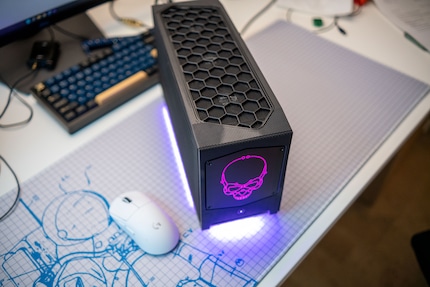
The heart of the NUC 12 Extreme is the Compute Element. Here, you’ll find the socket LGA 1700 mainboard. The new socket takes up more space than that of the notebook processor of the NUC Extreme 11. That’s why the NUC 12 Extreme has one less M.2 slot than its predecessor.

Either an i9-12900 or i7-12700 is installed as a processor. The i9 has eight performance and eight efficiency cores. Within the hybrid processor design, the performance cores are active during compute-intensive tasks like gaming. During less intensive tasks such as word processing or web browsing, the efficiency cores come to the fore. The i7 has eight performance cores and four efficiency cores built in. My test device comes with the i9-12900.
Unlike the «real» desktop mainboards, Intel relies on DDR4 instead of DDR5 support – which is a good decision, given that DDR5 RAM is as scarce and pricey as ever. My test device has 16 GB of built-in RAM.

The graphics card can be a maximum of 30.5 centimetres long, two slots thick and draw on a maximum of 350 watts of power – more than enough for an RTX 3080 Ti. My test device is equipped with a GeForce RTX 3060 Ti.
Here are my mini PC’s specifications:
| CPU | Intel Core i9-12900 |
| Graphics card | Nvidia GeForce RTX 3060 Ti |
| RAM | Crucial 16 Go de RAM DDR4-3200 |
| Storage | Samsung 980 Pro 1 TB SSD |
| Internal ports | 1 x PCIe x16 Gen5
3 x M.2 2280 PCIe x4 Gen4 1 x Intel WiFi 6E and Bluetooth 5.2 |
| External ports | 2 x Thunderbolt 4 type C
7 x USB 3.2 Gen2 type A 1 x USB 3.2 Gen2 type C 1 x 2.5 Gigabit LAN 1 x 10 Gigabit LAN 1 x SDXC Card reader 1 x 3.5 Headphone jack |
| Dimensions | 35.7 cm x 18.9 cm x 12 cm |
| Power supply | 650 watts |
An i9-12900 in a small system like the NEC 12 Extreme may sound good, but a processor with over 200 watts of power needs a proper cooling system. My tests with the new Intel stock coolers revealed that they were too weak to dissipate an excess of 200 watts of power. And the NUC 12 Extreme’s cooling capabilities are even more limited. With that in mind, I limited the power that the i9 could draw upon during my review to 65 watts in the BIOS. Otherwise, the NUC 12 Extreme would really have been breathing fire.
Sixty-five watts is the so-called Processor Base Power. The 12900, on the other hand, can draw on up to 202 watts. Great in itself – especially for systems that can handle that kind of heat generation. If you allow the processor to go into Turbo Power mode, it hits its thermal limit and reduces the clock rate. For this reason, the NUC 12 Extreme runs more comfortably at 65 watts.
Seeing as I don’t have a comparable test device, it’s tricky to judge the Dragon Canyon’s performance. As the predecessor model – the NUC 11 Extreme – was broken, I don’t have any results for it. That’s why I’ve compared the CPU-specific results with those from my review of the i9-12900K (linked article in German). This way, you’ll know right away what kind of losses result from limiting the CPU’s power to 65 watts.
To get an impression of the noise level and temperatures both when idle and when at work, I subjected the built-in components within the chassis to stress tests. These included AIDA64 for the CPU and FurMark for the GPU. I ran them for 20 minutes, using HWiNFO64 to measure the CPU and GPU temperatures. I left the fan control on the standard setting in the BIOS.
While idle, I measured a noise level of 35 dB at a distance of 30 centimetres from the chassis. Nice and quiet. When it has to perform, however, the NUC 12 Extreme roars at 46.5 dB. This is enough to bother me when I’m working or gaming.
At least the CPU was able to cool off sufficiently over the course of the test. The i9-12900 hit a maximum of 83 degrees Celsius. It clocked at an average of 3.2 GHz on the performance cores and 2.7 GHz on the efficiency cores.
Meanwhile, the GPU remained at a relatively cool maximum of 69 degrees Celcius. Given the size of the chassis and the tight space inside, that’s a respectable result.
Cinebench R20 and R23 measure the performance of a CPU when 3D models are being rendered.
In the benchmark, the NUC 12 Extreme’s i9-12900 reached a single core score of 705 and a multi-core score of 7,228. For comparison, the i9-12900K scored 745 points in the single core and 10,247 points in the multi-core areas. The 5.5 point difference between the single cores isn’t that considerable. With a 30 per cent difference between the multi-core scores, however, it’s clearly distinguishable. This demonstrates what a difference the 65-watt limit makes.

A similar picture emerges with the Cinebench R23. With an 8 per cent difference in single cores, the two CPUs are practically neck and neck with each other. The multi-core difference of around 35 per cent, on the other hand, is significantly greater.

The CPU-Z benchmark tests the CPU’s speed in both the single and multi cores and uses it to calculate a score.
Yet again, the i9-12900K trumps the i9-12900. That said, the difference – at just 7.5 per cent in the multi-core area – isn’t as significant as it is with Cinebench. The CPU-Z benchmark is considerably shorter than Cinebench’s benchmarks. In this case, the duration of the test might have had an impact on the result. Respectively, the limitation to 65 watts may not have made a big difference due to the short test duration.

In version 3.0 and above, the Blender benchmark renders three scenes and tallies up three scores from them. I’ve added these up to give end scores for each. This test again reveals that the 12900 is no match for the 12900K due to its 65-watt limitation. The 12900 scores 197 points, while the 12900K comes in at 363.

For the Handbrake test, I encode the 88-second-long H.264 compressed 4K trailer for «The Dark Knight Rises», choosing the «Fast 1080p30» presets.
Here, the difference between the two processors is even starker: the 12900 takes 52 seconds to finish the job, whereas the 12900K manages it in 33. That means the 12900 is about as fast as the 11900K, which took 50 seconds to complete the task.
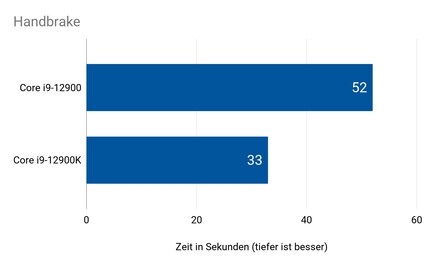
Using the Photoshop benchmark from Puget Systems, I ran different workloads. You can find more detailed information on that here. At the end, the benchmark calculates a score based on the reference workstation.
I can’t compare this to my review of the i9-12900K. The benchmark is dependent on the graphics card, which in this case was an RTX 2080 Super. However, I did find a result in the Puget Systems database involving an i9-12900K with an RTX 3060 Ti. The result shows that in Photoshop, the i9-12900 in the NUC 12 Extreme might not compete with the i9-12900K in a fully fledged desktop. The 12900K scored 17.5 per cent more points.
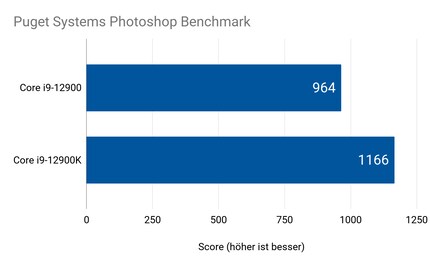
The PCMark 10 benchmark tests diverse scenarios such as app loading times, the efficiency of spreadsheet calculations, web browsing and photo and video editing. In other words, it demonstrates how suited a processor is to office work. From that, it calculates a score.
Like with the Photoshop benchmark, I can’t compare these results to my own data. However, a glance at the database from 3DMark, the developer of PCMark 10, shows that the NUC12 Extreme doesn’t come off too badly here. Except for the two top results, the i9-12900 is a decent contender (as of 14 March 2021). Comparable systems score 8,269 on average against the NUC’s 8,184.
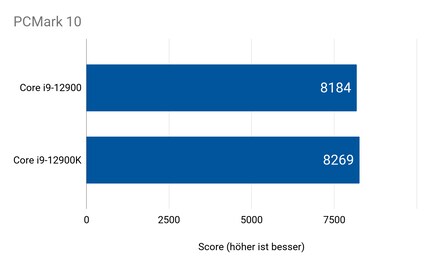
Unfortunately, I can’t add any of my own results for the game benchmark. Like many of you, it’s been almost two years since I was able to get my hands on a graphics card to test. Because of that, I’ve incorporated some results I found online at GPU Check. Given that I don’t know exactly how well their systems work, you should take these comparisons with a pinch of salt. Here you can see the figures in average frames per second (FPS).
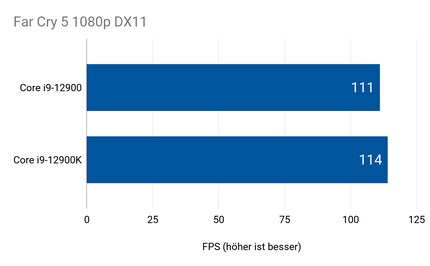


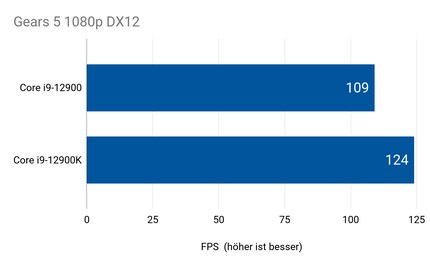
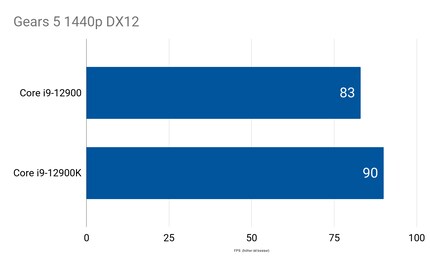

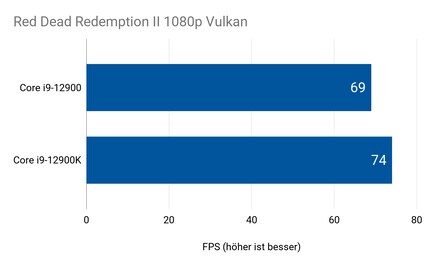
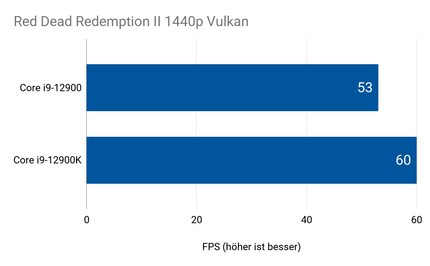

A picture similar to that of the other applications emerges. The i9-12900 is slower when it’s restricted to 65 watts than the i9-12900K without restrictions. Interestingly, the difference is greater in higher resolutions than in lower ones. Normally, it’s the other way around, as the higher resolution demands more processing power from the graphics card. I can’t explain why that is. I suspect that it has something to do with the results from GPU check. I just don’t know what kind of conditions brought them about.
That said, you can conclude that the resolution comfort zone of an RTX 3060 Ti – between 1080p and 1440p – allows for pretty decent gaming on the NUC 12 Extreme. The frame rates tend to hover around 60 FPS.
You should definitely limit the NUC 12 Extreme’s CPU to 65 watts; otherwise, it’ll overheat. Once restricted, the Dragon Canyon NUC is an effective gaming machine that also delivers a solid performance in other areas of application.
In comparison to an i9-12900K whose power hasn’t been restricted, the i9-12900 trails well behind. Depending on the application, this ranges from 5.5 per cent to almost 60 per cent lower performance. On paper that’s a huge difference – but this contrast varies greatly depending on the area of application.
The NUC 12 Extreme is an exciting device in itself but, much like the NUC 11 Extreme, I can’t peg it to a clear target group. If you want something small, you’ll be better served by a mini ITX PC, even if it is slightly bigger. And if that weren’t enough, the Dragon Canyon costs a hell of a lot. My test device cost a whopping 1,433 francs (as of 24 March 2022) – and that was without RAM, an SSD or a graphics card. You could put together a comparable mini ITX PC for the same amount of money with the RAM and SSD included.
So, I guess the NUC 12 Extreme is made for the kind of person who only exists in legends – dragon tamers.
From big data to big brother, Cyborgs to Sci-Fi. All aspects of technology and society fascinate me.